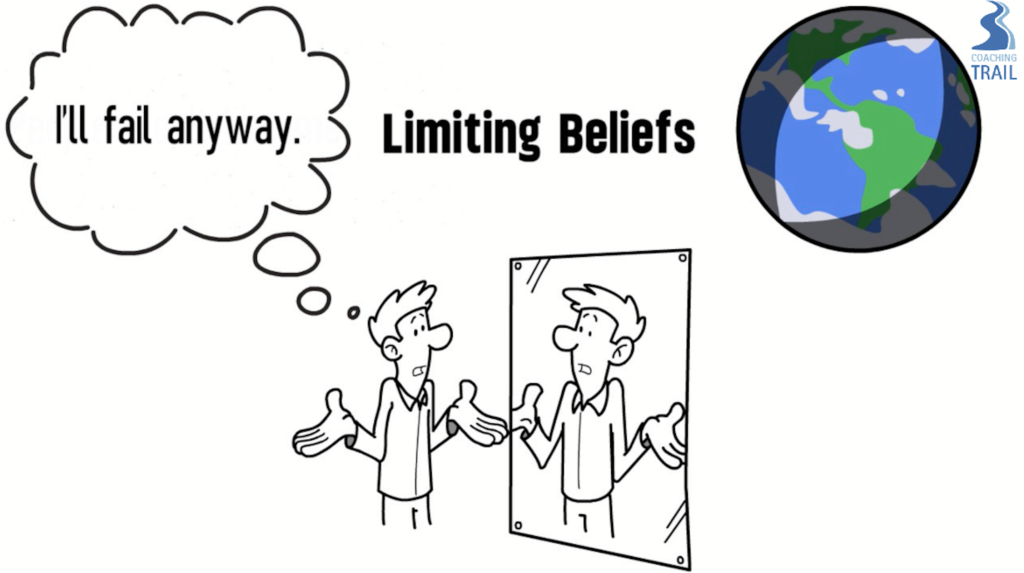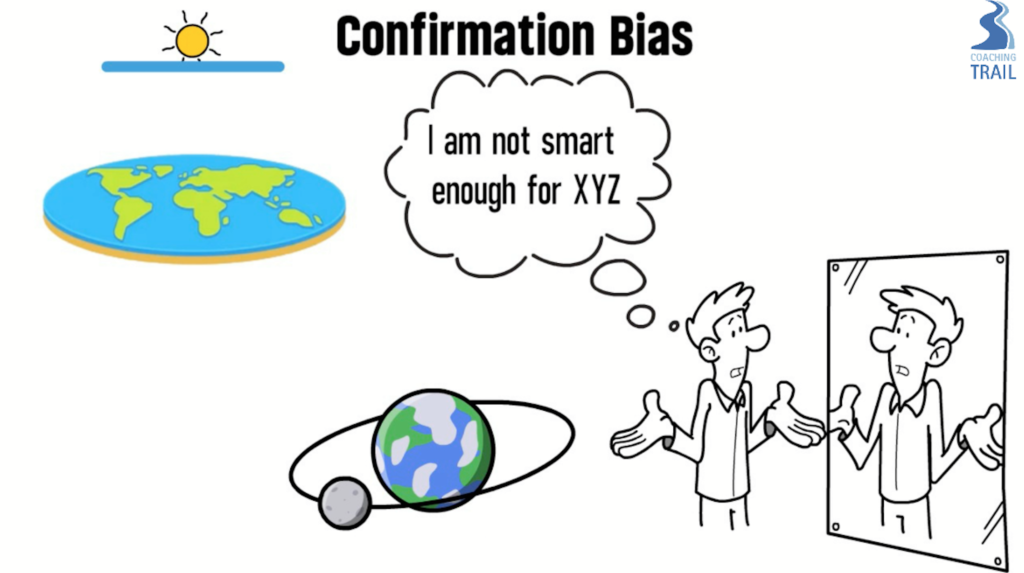Limiting Beliefs
Let’s start with a simple question: is the Earth flat? Take a look at the horizon line; you may believe you see evidence confirming this! Without additional information that you received as part of education, it might be easy to fool yourself and believe the Earth is indeed flat. This simplistic example put aside, we live with similar false ideas and beliefs every day, mostly about ourselves:
“I’m not smart enough to do this.”
“I’ll never progress in my career unless I am perfect.”
“It’s better not to try than to fail.”
“People won’t like me if I act myself and if I don’t please them,” and so on.
Does any of these ring a bell?

To watch a short video about Limiting Beliefs and Confirmation Bias, click at the bottom of the article.
These statements about yourself are limiting beliefs. They distort the way you see yourself and the world around you, restricting the true scope of what is available to you. You see less of who you are and what you are truly capable of, causing you to miss opportunities. Imagine hoping to buy a pair of sunglasses so that you can enjoy a sunny summer day and choosing to settle for a pirate eye patch instead. Why would you limit your views like that and rob yourself of the view and the sunlight? Even worse, wear that patch for long enough, and you might start believing that your perception of the view around you is the most accurate view of the world; as a result, you start to believe that what you see is all there is and all you get.
Confirmation Bias
Many of our core beliefs form in early childhood, and we believe them to be unquestionable truths. They create a lens through which we see the world. This lens narrows and filters the information that we perceive. When we have a belief about ourselves or others, our brain locates the data supporting that belief and discounts the information that goes against it. In psychology, this is called confirmation bias. Despite limiting beliefs about ourselves often being patently false, we consider them valid and furthermore, look around for confirming evidence. It is like believing that the Earth is flat on the basis of seeing a horizon, but discounting all the scientific evidence that disconfirms it. So just like those who perceive the Earth is flat, we discount the evidence and explain away the information that doesn’t match our world view – because the Earth is flat, right?

To watch a short video about Limiting Beliefs and Confirmation Bias, click at the bottom of the article.
Sub-Optimal Behaviours and Bad Habits
Limiting beliefs are responsible for us allowing sub-optimal behaviours and habits to creep into our brains and our lives in the first place. They eventually start negatively impacting us. And when we realise that a change for the better is necessary, these same limiting beliefs will often keep us stuck. It’s that resistance to start your exercise routine, even as you pat your tummy, or the desire to learn a new skill so you could land a new job that just gets swamped by procrastination. The change you dream of making could make the most significant positive difference to your life, your career, your personal life, or your wellbeing, and yet you fail to enact it repeatedly.
You probably tell yourself that you don’t know why, but it feels like something inside you is holding you back from succeeding. It’s a safe bet that limiting beliefs are holding you back. You probably tell yourself that it isn’t your fault – but if you let those limiting beliefs control you for the rest of your life, you are unconsciously making a decision to allow them to do so.
Overcome Resistance to Change with Immunity To Change Mapping
This is where Immunity To Change Mapping can help you. Immunity to Change Mapping is a groundbreaking framework by Harvard Graduate School of Education faculty members Professor Robert Kegan and Lisa Lahey, Ed.D. Instead of taking a traditional focus on motivation, perseverance and planning, this framework looks at change differently. The Immunity to Change Mapping helps discover what will hold you back from making a change if left unaddressed. It is about finding your Big Assumptions, limiting beliefs or whatever you may call them. These beliefs are an essential source of information about your past, giving you a roadmap to address these and change your future.
To engage in Immunity to Change Mapping exercise, I invite you first to note down:
WHAT IS ONE SIGNIFICANT CHANGE THAT WOULD MAKE THE BIGGEST DIFFERENCE IN YOUR LIFE?
Perhaps you’ve tried to make this change in the past and failed? It can be work-related or personal. For instance, you may wish to delegate more to your team members, become a better listener, learn to focus on critical issues, prioritise your self-care, keep to a consistent sports routine, etc. The questionnaire at the bottom of this article will help you answer this question.
Immunity To Change Mapping Steps
Once you have your improvement change goal down on paper, you can attempt the Immunity to Change Mapping process yourself. Of course, this is no easy task; if it were, you would have enacted that change already, right? Alternatively, you may wish to join the Immunity to Change Mapping Workshop or book individual one to one sessions. I am here to support you however you wish to proceed. Here is the Immunity to Change method sequence for those wishing to try at least some of the steps alone:
1. Firstly, ensure you really get to the core of the matter and define your improvement change goal well. Reflect what you need to get better at in order to get outcomes important to you. Consider feedback you may have received about your behaviours from your colleagues, family or friends; this external feedback may be offering a gift of magnifying your blind spots. The more definitively you define this improvement change goal, the more effective this exercise will be. If you’re unsure, the questionnaire at the bottom of this article will help you formulate your starting point.
An example of an improvement goal for someone who has been recently promoted at work and is transitioning from an expert to a managerial role and is struggling to make a shift from detailed operational to more strategic perspective: I am committed to get better at focusing on strategy and going beyond details.
2. List any behaviours or actions that you do (or fail to do) that are against your improvement goal. Here it is important to stay with observable behaviours. Consider this: if someone was to film you over a period of a month, what would they observe you do (or not do) that is against your stated goal? If you were to respond with something like: ‘I get worried and depressed’, how does this worry and depression manifest itself as an observable behaviour?
An example of behaviour against the improvement goal: I spend most of my day on completing minor non-strategic tasks that can be delegated to my team.
3. Next, examine: what are you worried may happen if you were to do the opposite of the behaviours you listed in step 2? This will allow you to identify the cause of resistance, which enables you to take the next step and translate those worries into the hidden commitments holding you back. You generally won’t have given these any conscious thought. You are likely to uncover a strong motivation that contradicts your stated goal. It’s important to realise this may not be an easy step – if done with honesty, your hidden commitments are generally not noble. Instead, they are often about protecting your perceived identity or defending yourself from primitive fears! If your hidden commitments are noble, repeat this part of the exercise as you have not been honest with yourself.
An example of a worry against the improvement goal: If I focus on important strategic tasks instead of minor ones, I worry that others will notice that I am out of my depth and not knowledgeable enough. This example of a worry leads to an example of a hidden commitment: I am also committed to not appearing to others as out of my depth and not knowledgeable enough.
4. Finally, you will have to be courageous to look at what’s truly behind the hidden commitments that you uncovered in step 3. You may be examining deep-seated fears or issues that deal with your self-perception. In turn, this process may help you reveal underlying matters about yourself. Ask yourself a question: ‘What assumptions I must hold that make my worries/hidden commitments, revealed in step 3, exist? Here you discover the cousin of limiting beliefs, your Big Assumptions. This information arms you with everything you need to build your roadmap to changing your future!
An example of a Big Assumption: I will be a failure if if I appear to others as out of my depth and not knowledgeable enough. I assume that my value depends on what other people think about me.
Considering the examples used in 1-4, if you do not address these Big Assumptions that you have, i.e. “I will be a failure if if I appear to others as out of my depth and not knowledgeable enough and I assume that my value depends on what other people think about me”, you are likely to have a real struggle to succeed in your improvement change goal of “focusing on strategy and going beyond detail” despite your motivation and the importance of the change goal (a successful transition from an expert to a manager).
5. Immunity to Change Mapping does not simply help you identify your limiting beliefs or Big Assumptions and then leave you stuck. Instead, once you complete your Immunity to Change Mapping, it enables you to design gradual real-life experiments to test your Big Assumptions in a way that guides you to look for proof that disconfirms them. If we refer back to confirmation bias, the aim here is to do the opposite to what our brains would naturally do. In other words, the process gets you to notice all the facts and information out there and available but that was previously invisible to you because of that cloud of Big Assumptions that you carry.
A couple of test examples: I will reflect and write a short history of when this Big Assumption started in my life to generate knowledge about its roots and assess if it is still relevant to me today. I will talk with someone who knows me well and whom I trust if they ever witnessed me being out of my depth to understand whether they consider me a failure as a result. Etc.
It is now, in step 5, that the real breakthroughs happen: your limiting beliefs and Big Assumptions start losing the grip that they had on you and you can move forward with the changes that are important to you!
Join Online Workshops or One-To-One Sessions with Coaching Trail
When doing Immunity to Change Mapping exercise alone, be aware that without the right level of external support and challenge, you may struggle to delve far below the surface risking to not get to the root cause of what truly holds you back. You may prefer a guided and supported journey on this quest for self-discovery. If so, I would like to invite you to join me for an Immunity to Change Mapping workshop. This workshop is a safe space where a small number of people like you will be working on their improvement goals together, with my guidance. Alternatively, you may wish to opt for individual one-to-one Immunity to Change Mapping sessions so that our work together is focused only on you. Whatever you prefer – a workshop or individual sessions, I promise that you will discover your reasons for what holds you back from succeeding in change. I will help you understand how you can move forward and grow, closing the gap between your good intentions for change and your actual behaviours.
Click the links below:
REGISTER for Immunity To Change Workshop or BOOK One-To-One Sessions
QUESTIONNAIRE to help you formulate Your Improvement Change Goal
SHORT VIDEO on Limiting Beliefs and Confirmation Bias

Jurgita Micallef is a seasoned Leadership and Executive Coach, PCC accredited by International Coaching Federation and trained in Immunity To ChangeTM method by Minds at Work.




You must be logged in to post a comment.